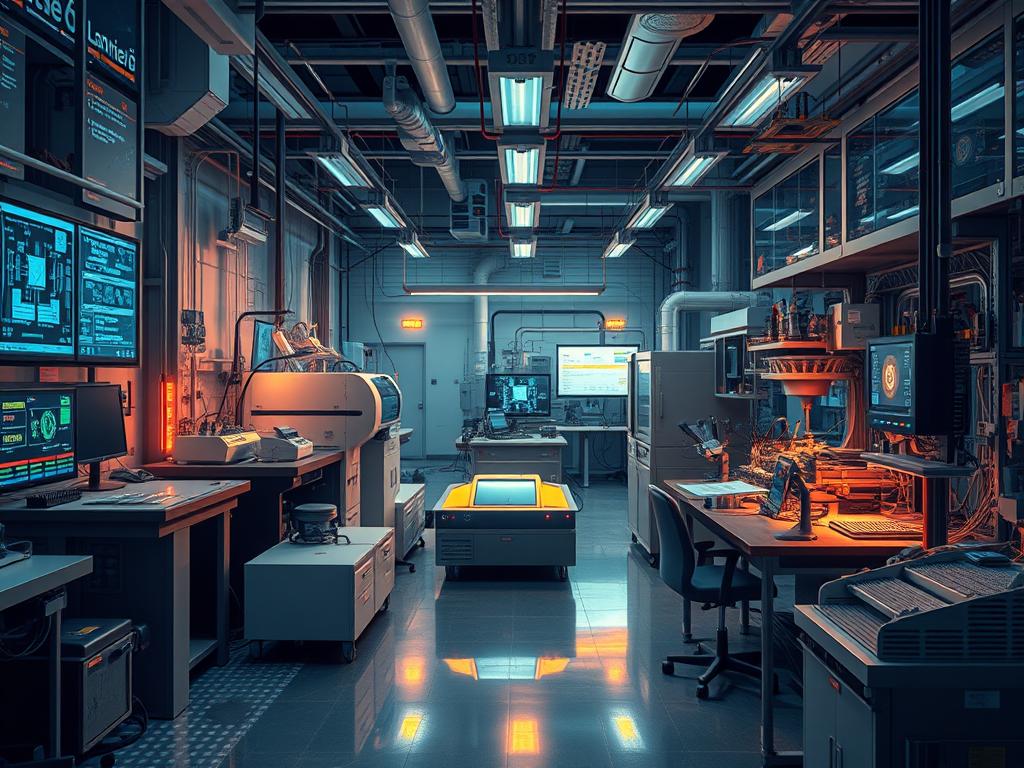Phase-change memory (PCRAM) drastically reduces power needed to write data. This technology is revolutionizing advanced memory, enabling more efficient and powerful computing systems.
Phase-Change Transistor Elements offer non-volatile states for data storage. They can potentially store more data than flash memory or DRAM. These elements use high and low resistance states to create binary data.
PCRAM devices now operate at 40-nm size and 0.7 volts. They switch in about 40 nanoseconds and use less than 1.5 picojoules. This efficiency is crucial for processing large amounts of data in various applications.
Phase-Change Transistor Elements have potential beyond memory storage. They can be integrated into logic chips for seamless logic and memory operation. This integration could significantly improve computing performance and energy efficiency.
These elements use logic transistors for control. This advancement opens new possibilities in computing and data storage. Let’s explore the properties, applications, and challenges of this innovative memory technology.
Understanding Phase-Change Materials
Phase-change materials (PCMs) are crucial for innovative memory technologies. They switch between amorphous and crystalline states, creating non-volatile memory solutions. Let’s explore PCMs and their fascinating properties.
What Are Phase-Change Materials?
PCMs change their physical state when temperatures vary. In electronic memory, PCMs are usually Chalcogenide Materials. They quickly switch between amorphous and crystalline phases.
This Amorphous-to-Crystalline Transition is vital for memory devices. It allows for efficient data storage and retrieval.
Key Properties and Mechanisms
PCMs have unique properties that make them perfect for data storage:
- Rapid switching between states (less than 1 ns)
- Stable amorphous phase (up to 10 years at 100°C)
- Large resistance change between phases
- Low power consumption
Electrical pulses program and read the material’s state. This method doesn’t need constant power, making it energy-efficient.
Types and Examples of Phase-Change Materials
Various PCMs are used in cooling and memory applications. Here are some examples:
| PCM Type | Example | Application |
|---|---|---|
| Salt-hydrates | Glauber’s salt | Cooling devices |
| N-alkanes | Paraffins | Thermal management |
| Chalcogenides | Ge2Sb2Te5 (GST) | Memory storage |
Ge2Sb2Te5, or GST, is a popular chalcogenide compound for phase-change memory. It switches quickly and remains stable, making it ideal for new memory technologies.
Applications of Phase-Change Transistor Elements
Phase-change transistor elements are changing memory storage and computing. They use Phase-Change Memory (PCM) to boost performance and efficiency in various applications.
Memory Storage Technology
Phase-Change Memory offers major benefits over traditional options. It’s as fast as RAM and non-volatile like flash storage. This makes it a strong contender for universal memory solutions.
Phase-Change RAM (PRAM) has been created for secondary storage. It shows fast switching speeds and long-lasting endurance cycles, similar to DRAM.
Computing Devices
Phase-change transistor elements have huge potential in computing devices. They can combine memory and processing functions into one device. This cuts energy use and processing time, making computers more efficient.
New research shows phase-change memories can do math and logic like CMOS-based processing cores. This opens up exciting possibilities for future computer designs.
Impact on Consumer Electronics
Phase-change transistor elements are making big changes in consumer electronics. They allow for smaller, more powerful devices with better heat control. Advanced composite PCMs keep electronic devices cooler, making them last longer.

Ovonic Unified Memory and Resistive Random-Access Memory use phase-change materials. These technologies push the limits of consumer electronics. They promise faster, more efficient devices with more storage.
| Technology | Advantage | Application |
|---|---|---|
| Phase-Change Memory | Non-volatile, fast switching | Universal memory |
| Ovonic Unified Memory | Low power consumption | Mobile devices |
| Resistive Random-Access Memory | High storage density | Data centers |
Benefits of Phase-Change Transistor Elements
Phase-change transistor elements offer unique advantages in memory technology. They use materials that switch between states, enabling energy-efficient memory solutions. These components have remarkable capabilities for data storage and processing.
Non-Volatility Explained
Phase-change transistor elements are non-volatile, retaining data without constant power. This is achieved through melt-quenched amorphism, creating a stable amorphous state.
Unlike traditional volatile memory, these devices can store information for long periods. This makes them ideal for applications requiring persistent data storage.
Speed and Efficiency Advantages
Phase-change memory (PCM) technologies show impressive speed and efficiency:
- Access latencies of tens of nanoseconds
- Write endurance ranging from 10^4 to 10^9 cycles
- Projected endurance improvements up to 10^12 writes at 32nm
PCM could replace flash memory in certain applications. Its threshold switching mechanism allows for rapid state changes.
This contributes to PCM’s high-speed operation, making it a strong contender in memory technology. Its efficiency and speed make it suitable for various uses.
Integration with Existing Technologies
Phase-change transistor elements work well with current semiconductor technologies. They use a one-transistor, one-resistor (1T1R) structure, making integration with CMOS logic easier.
This compatibility allows combining logic and memory functions on a single chip. Such integration could revolutionize computer architectures, improving overall system performance.
“Phase-change materials like vanadium dioxide (VO2) exhibit fascinating transition characteristics, switching from insulator to metallic states at specific temperatures. This property could enable novel applications in reconfigurable intelligent surfaces for wireless and optical systems.”
Phase-change materials have potential beyond traditional memory applications. They show promise in analog machine learning circuits and multi-bit storage systems.
As research advances, these energy-efficient solutions may reshape computing and electronics. Their versatility opens doors to new possibilities in various technological fields.
Challenges and Limitations
Phase-Change Transistor Fabrication faces major hurdles. Creating these advanced devices requires precision and innovation. The process is complex and demands careful attention to detail.
Manufacturing Difficulties
Crafting phase-change transistors needs precise control over superlattice structures. Integrating new materials into existing fabrication is challenging. This delicate process affects yield rates and production efficiency.

Thermal Stability Issues
Thermal Management is crucial in phase-change transistor development. Temperature changes can greatly impact device performance. Engineers must create solutions to maintain stability in various conditions.
Cost Implications
New materials and techniques come with high costs. Balancing innovation and affordability is key. Industry leaders must overcome these financial hurdles for commercial success.
| Challenge | Impact | Potential Solution |
|---|---|---|
| Precise Superlattice Control | Reduced Yield Rates | Advanced Fabrication Techniques |
| Temperature Sensitivity | Performance Instability | Improved Thermal Design |
| High Production Costs | Limited Market Adoption | Scale Economies, Material Innovations |
The industry faces significant Scaling Challenges. Research focuses on improving endurance at higher temperatures. This work aims to unleash phase-change transistors’ potential in various applications.
Recent Innovations and Research
Phase-change technology is evolving rapidly, reshaping memory storage and computing. Recent breakthroughs have led to exciting developments in transistor design and performance.
Breakthroughs in Phase-Change Technology
The GST467 Alloy is a game-changer for phase-change memory devices. This novel material, integrated into a nanocomposite superlattice structure, shows remarkable potential.
It promises to create compact, fast-switching, and energy-efficient memory devices. Scientists have achieved impressive results with these new transistors.
- Ferroelectric “grains” measuring just 10 nanometers
- Creation of tunnel junctions using tiny grains
- Nearly perfect parabolic transfer characteristic
- Robust negative transconductance
Leading Research Institutions and Companies
Stanford University, the University of Maryland, and Taiwan Semiconductor Manufacturing Co. developed the GST467 Alloy. This partnership highlights the importance of innovative semiconductor materials in advancing transistor technology.
Other notable research includes:
- Lund University’s reconfigurable transistors using ferroelectrics
- A team led by Hong increasing the on-off ratio to 385
- Intel’s RibbonFET technology for new transistor designs
Future Trends and Developments
The future of phase-change transistor elements looks bright. Several exciting trends are on the horizon.
- 3D Memory Stacking: This technique could significantly increase memory density.
- Improved device endurance at higher temperatures
- Integration of phase-change memory into logic chips
- Development of neuromorphic circuits mimicking human brain synapses
These advances will transform the $600 billion semiconductor industry. As flexible transistors evolve, we’ll see improvements in wearable electronics and other cutting-edge applications.
Conclusion and Future Outlook
Phase-change transistor elements are revolutionizing future computing architectures. They offer a glimpse into universal memory, bridging volatile and non-volatile storage solutions. These innovations promise to reshape the technological landscape.
Summary of Phase-Change Transistor Potential
Phase change memory (PCM) technology has made rapid progress. It outpaces older technologies in scaling and large-array capabilities. PCM shows impressive retention, endurance, and performance, making it ideal for AI systems.
Anticipated Industry Changes
The solid-state drive market is booming, with revenues exceeding $400 million. This growth fuels demand for more efficient memory solutions. Phase-change transistors could revolutionize data processing and storage.
These elements operate at low voltages and work well with CMOS logic. This compatibility opens new possibilities for integrating logic and memory seamlessly.
Call to Action for Further Exploration
Phase-change transistor elements have potential beyond current applications. As AI dominates, further research is crucial. Exploring phase-change materials with 2D transition metal could boost computing power and efficiency.
The journey towards universal memory and revolutionary computing is just starting. The possibilities for advancement in this field are endless.


